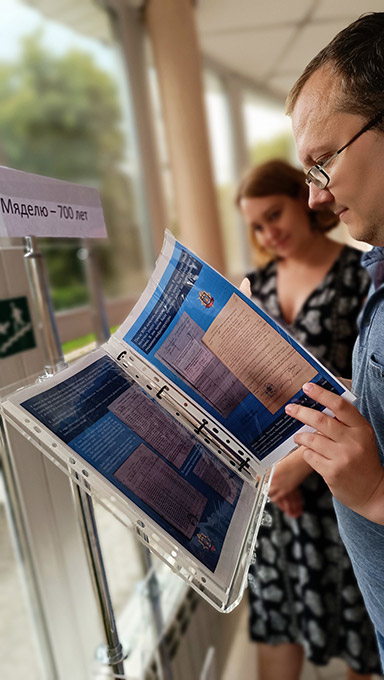On July 27, Myadel celebrates its 700th anniversary: Zonal State Archives prepared a thematic exhibition in Molodechno
On July 27, the city of Myadel, a city with a rich history and cultural heritage, celebrates its 700th anniversary. On this occasion, a thematic exhibition was placed in the foyer of the Zonal State Archive in Molodechno. It reflects the stages of development of the city and its surroundings, based on archival documents.
The exhibition takes you on a short excursion into the distant past of the settlement – the first mentions of settlements on these lands date back to the times of the Slavic tribes that lived here in the 1st millennium AD. Myadel was first mentioned in written sources in the 16th century. At that time, these lands were part of the Grand Duchy of Lithuania. The city was located on an important trade route, which contributed to its development. In the 17th century, Myadzel became part of the Polish-Lithuanian Commonwealth. At this time, the city developed as a commercial and cultural center. In the 18th century, after the divisions of the Polish-Lithuanian Commonwealth, Myadel came under the control of the Russian Empire. Since the beginning of the 19th century, it has become an important administrative and economic center. At this time, agriculture and crafts developed here. Myadel became a place of attraction for the Jewish population, which made a significant contribution to the economic life of the region.
At the beginning of the 20th century, the town continued to develop, but its history was interrupted by the events of the First and Second World Wars. During the war, Myadel suffered greatly, many buildings were destroyed, and the population suffered heavy losses. Evidence of them is now provided by archival documents kept by the zonal archive. The chronicle «tells»: during the years of German occupation (the city was occupied by the Nazis for 3 years), not a single Myadel Jew survived – they all died in the ghetto, of which there were 5 in the Myadel region. A separate program was developed for the extermination of the Jewish population, and she did not always act by direct murder. People died from disease, cold and hunger. For example, workers’ daily rations were reduced: it consisted of only 75 g of flour and 100 g of bread. Keeps an archive and name lists of those executed, hanged and tortured in those years.
After the war, a period of reconstruction began. In the 1950s, Myadel received the status of an urban village, and then was transformed into a city. The corresponding Decision is also in the archives. During these years, work was carried out to improve and create infrastructure. Documents confirm the facts of the creation and opening of new facilities, institutions and centers.
Today Myadel is a small but cozy city with a developed social infrastructure. The city has schools, hospitals, and cultural institutions. Local residents are engaged in agriculture and also work in the service and trade sectors. Myadel attracts tourists with its natural beauty, including Lake Naroch, which is located nearby. It is a popular destination for recreation and water sports, the hallmark of the region.
 |
| 1.Acquaintance with the exhibition |
 |
| 2.Acquaintance with the exhibition |
 |
| 3.Acquaintance with the exhibition |
 |
| 4. Decision of the Executive Committee of the Myadel District Council of Workers’ Deputies No. 297 of 04/22/1954. «On the opening of a kindergarten in Myadel in 1954» |
 |
| 5. Decision of the Executive Committee of the Myadel District Council of Workers’ Deputies No. 159 of 05/08/1958. «On the renaming of the village of Myadel, Myadel district to an urban village» |
 |
| 6. Decision of the Myadel district executive committee of the Minsk region No. 186 dated February 28, 2017. «On the creation of the Naroch Center for Culture and Leisure» |

